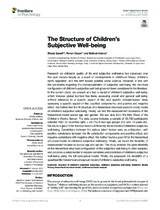| dc.contributor.author | Savahl, Shazly | |
| dc.contributor.author | Casas, Ferran | |
| dc.contributor.author | Adams, Sabirah | |
| dc.date.accessioned | 2022-02-16T10:35:27Z | |
| dc.date.available | 2022-02-16T10:35:27Z | |
| dc.date.issued | 2021 | |
| dc.identifier.citation | Savahl, S. et al. (2021). The structure of children's subjective well-being. Frontiers in Psychology, 12. 10.3389/fpsyg.2021.650691 | en_US |
| dc.identifier.issn | 1664-1078 | |
| dc.identifier.uri | 10.3389/fpsyg.2021.650691 | |
| dc.identifier.uri | http://hdl.handle.net/10566/7270 | |
| dc.description.abstract | Research on children’s quality of life and subjective well-being has advanced over
the past decade largely as a result of developments in childhood theory, children’s
rights legislation, and the shift toward positive social science. However, in line with
the uncertainty regarding the conceptualization of subjective well-being, the structural
configuration of children’s subjective well-being has not been considered in the literature.
In the current study, we present and test a model of children’s subjective well-being,
which includes global (context-free items assessing overall and general well-being,
without reference to a specific aspect of life) and specific (domain-based items
assessing a specific aspect of life) cognitive components, and positive and negative
affect. We further test the fit structure of a hierarchical structural (second-order) model
of children’s subjective well-being. Finally, we test the measurement invariance of the
hierarchical model across age and gender. We use data from the third Wave of the
Children’s Worlds Survey. | en_US |
| dc.language.iso | en | en_US |
| dc.publisher | Frontiers Media | en_US |
| dc.subject | Children’s subjective well-being | en_US |
| dc.subject | Children’s worlds survey | en_US |
| dc.subject | Children’s rights legislation | en_US |
| dc.subject | Gender | en_US |
| dc.title | The structure of children's subjective well-being | en_US |
| dc.type | Article | en_US |

